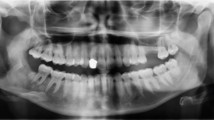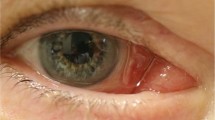Key Points
-
Highlights the resurgence of tuberculosis in the head and neck region, in particular the extrapulmonary type.
-
Presents an extremely unusual nodular presentation of oral tuberculosis that usually presents as a non-healing ulcer.
-
Discusses an important differential diagnosis of an apparent oral malignancy with cervical lymph node enlargement.
Abstract
We report a case of a 38-year-old male who presented to us with a nodular swelling of the tongue with cervical lymphadenopathy suggestive of a malignancy. The lesion was diagnosed to be of tuberculous origin and the patient responded well to anti-tubercular chemotherapy.
Similar content being viewed by others
Case report
A 38-year-old male presented to us with a progressively increasing, painless and non-tender swelling of the tongue of four months' duration. There was no history of fever, dysphagia or dysphonia. The patient had been a heavy smoker for the past 20 years, smoking 20 cigarettes a day. Examination revealed a well-defined, firm and nodular swelling measuring 1.5 cm × 1 cm involving the dorsum of the oral tongue to the right of the midline (Fig. 1). Tongue mobility was normal. The patient was also found to have a firm and mobile right submandibular lymph node measuring 2 cm × 1 cm.
The routine blood investigations were within normal limits except for a raised ESR (24 mm in the first hour). The ELISA for HIV (using a kit manufactured by Standard Diagnostic Inc, Korea) was non-reactive (a single reading) and a chest radiograph was normal. A fine needle aspiration cytology (FNAC) was performed from the tongue mass that revealed a caseating granulomatous lesion strongly suggestive of tuberculosis (Fig. 2). The aspirated material stained positive for AFB (acid-fast bacilli) using 20% sulphuric acid. Culture of tissue homogenate for pyogenic bacteria, mycobacteria and fungal organisms revealed no growth. For detecting mycobacteria, inoculation was done on IUAT-LJ (International Union Against Tuberculosis — Lowenstein Jensen) medium at 37°C, which showed no growth even after eight weeks. ELISA for antimicrobial-IgM (using a kit manufactured by Omega Diagnostic) was carried out to confirm the diagnosis and was found to be reactive in 1:200 dilutions.
Differential diagnosis
Our patient presented to us with a mass lesion on the dorsum of the tongue with a palpable node in the ipsilateral submandibular region. The relatively short history of the mass (four months), strong history of smoking (20 years) and the examination findings of a firm mass with cervical lymphadenopathy were in favour of a malignant pathology. It was only on an FNAC that the diagnosis of tuberculosis was considered and was further confirmed by AFB staining and positive ELISA for Mycobacterium Tuberculosis. A similar picture on FNAC is also seen in atypical mycobacterial infections, sarcoidosis and lymphomas. To complete the list, epithelial proliferating lesions, fibromas, cysts, angiomas, pyogenic granulomas and pleomorphic adenomas may be considered in the differential diagnosis of such an oral mass.1
Treatment
The patient was put on a four drug anti-tubercular treatment (isoniazid, rifampicin, pyrazinamide and ethambutol) for two months followed by two drugs (isoniazid and rifampicin) for four months with complete recovery. The patient was totally asymptomatic for the disease six months following the completion of treatment.
Comments
In spite of the increasing incidence of the mycobacterial diseases in many parts of the world, especially the extrapulmonary type, it is still an underdiagnosed entity.2 This is partly due to the occasional uncommon clinical presentations with involvement of atypical sites.
The oral cavity accounts for 0.2 to 1.5% of all the cases of extrapulmonary tuberculosis and is mostly secondary to pulmonary tuberculosis.3 Thus, primary tuberculosis of the oral cavity is exceedingly rare with the tongue being the most commonly affected site.4,5 Tuberculosis of the tongue almost always presents as a chronic, non-healing ulceration.3,4 We have not been able to identify any case of lingual tuberculosis presenting as a well-defined mass in a review of the medical literature. This makes the present case extremely unusual, which prompted us to report it. Cervical lymphadenopathy may be associated with oral tuberculosis as was seen in our case.
The diagnosis in our case was established only after an FNAC which thus emphasises the role of this investigation in the diagnosis of such tongue masses. Histopathologically, the presence of caseating granulomas is strongly suggestive, but not diagnostic of tuberculosis, as a similar picture may be seen in atypical mycobacterial infections also. In the same way, atypical mycobacteria may also present as acid-fast bacilli on appropriate staining. Thus, the diagnosis was further confirmed by a raised ESR, positive ELISA and rapid, complete response to standard anti-tubercular treatment. A newer diagnostic modality that can be used with a high specificity in the diagnosis of oral tuberculosis is PCR (Polymerase Chain Reaction) technique.6 But due to the unavailability of this technique as a routine diagnostic test in our institute, this test could not be performed. In conclusion, we would like to emphasise that:
-
Primary tuberculosis of the tongue is a rare condition and a nodular presentation is even rarer.
-
Tuberculosis should be kept in the differential diagnosis of a tongue mass suspected to be malignant.
-
FNAC plays an essential role in establishing the diagnosis in such a situation.
References
Ono Y, Takahashi H, Inagi K et al. Clinical study of benign lesions in the oral cavity. Acta Otolaryngol Suppl 2002; 547: 79–84.
Al-Serhani M . Mycobacterial infections of the head and neck: Presentation and diagnosis. Laryngoscope 2001; 111: 2012–2016.
Iype EM, Ramdas K, Pandey M et al. Primary tuberculosis of the tongue: report of three cases. Br J Oral Maxillofac Surg 2001; 39: 402–403.
Jaward J, El Znebi F . Primary lingual tuberculosis: a case report. J Laryngol Otol 1996; 110: 1778–1780.
Miziara I . Tuberculosis affecting the oral cavity in Brazilian HIV-infected patients. Oral Surg Oral Med Oral Pathol Oral Radiol Endod 2005; 100: 179–182.
Eguchi J, Ishihara K, Watanabe A et al. PCR method is essential for detecting Mycobacterium tuberculosis in oral cavity samples. Oral Microbiol Immunol 2003; 18: 156–159.
Author information
Authors and Affiliations
Corresponding author
Additional information
Refereed Paper
Rights and permissions
About this article
Cite this article
Sareen, D., Sethi, A. & Agarwal, A. Primary tuberculosis of the tongue: A rare nodular presentation. Br Dent J 200, 321–322 (2006). https://doi.org/10.1038/sj.bdj.4813319
Accepted:
Published:
Issue Date:
DOI: https://doi.org/10.1038/sj.bdj.4813319
This article is cited by
-
Tuberculosis of Oral Cavity: A Series of One Primary and Three Secondary Cases
Indian Journal of Otolaryngology and Head & Neck Surgery (2013)
-
Tubercular Ulcer: Mimicking Squamous Cell Carcinoma of Buccal Mucosa
Journal of Maxillofacial and Oral Surgery (2012)





